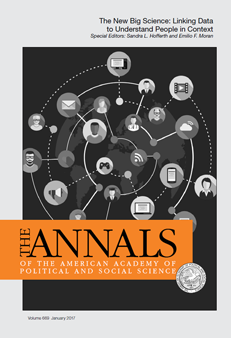High-quality social science is an indispensable public good. Social research helps us understand who we are (e.g. changes in family structure and civic life), describes phenomena that require our attention (e.g. educational needs of the workforce and the erosion of the middle class), and gives us a sense of what public policy can contribute to a healthy, just and peaceful world (has the safety net raised children out of poverty? Have immigration policies achieved their goals?). Science continues to make great contributions in the social sphere, but scientific explanations tend to be fragmentary and discipline-bound, often making science-based prescriptions for change informed, but unproven.
Doing social research comprehensively and effectively in the modern world means finding new ways of integrating and leveraging the vast information that is now available to researchers, and also incorporating new tools – particularly social media and administrative data – into analyses in ways that account for regional and local variation. For the most part, social scientists employ tools and a data infrastructure that have not changed much since the 1960s, but developments in information technology offer an unprecedented opportunity to collect diverse data at fine-grained spatial and temporal scales.
This volume of The Annals shows a way forward for the social and behavioral sciences, proposing a network of regional data centers (social observatories) that could be, when fully developed, a national resource for the assembly, documentation, curation, and dissemination of data that represents the entire U.S. population and its diverse regions.
The special editors of the volume argue for the creation of social observatories and give a detailed, technical accounting of how a network of about 20-25 of them could continuously monitor about 400 census tracts that are representative of the broader national population. The regional centers would work with local and state governments to gain access to administrative data in the region, and supplement national and local data with new survey and qualitative research. The result would be regional data that would enable an encourage extraordinarily fine-grained and detailed social analysis linked to other types of data in order to have a comprehensive picture of people in context.
Notably, regional and local data centers are already growing in a number of communities across the United States, so this volume also presents original empirical work that gives a sense of what is possible and already happening through research that capitalizes on linked data. These concrete examples show how research using linked data can advance our understanding of Americans’ lives. We cover a broad range of topics, including monitoring the health and well-being of the population; assessing the impact of social programs; measuring the status and wellbeing of families and neighborhoods; planning for and responding to environmental hazards; and developing new approaches to the study of movement, mobility, and migration.
Research findings presented here include:
- Work from the Washington DC area that connects the physical characteristics of communities to human behavior by using data from Google StreetView to better assess physical infrastructures that facilitate or hinder the mobility of the aged: There is substantial variation across cities, but Black and Latino residents tend to live in neighborhoods with higher disorder than Whites.
- Research on adolescent behavior that uses smartphones to map kids’ “activity spaces” and links that information to local administrative data, showing how exposure to violent locations could threaten mental/physical health. Neighborhood disadvantage accounts for almost 40% of the African American-White disparities in exposure to violence, but accounting for more specific measures of “activity spaces” explains an additional 33% of exposure to violence and eliminates the racial disparity between African American and White youth.
- Research that links federal surveys with state and federal administrative data to measure family status and leads to better and more reliable evaluations of participation in social welfare programs.
- A novel linkage of Twitter data, health survey data, and socioeconomic data from the U.S. Census Bureau to predict communities’ asthma burden. Asthma-related tweets were a significant predictor of asthma prevalence in communities, and there was substantial variation in the link between the tweets and socioeconomic status across regions, suggesting that the asthma burden may vary across communities.
- An examination of the health of residents of low-income areas in the city of Dallas that links medical record data with community service administrative data and housing appraisals to show how families cope when a key member experiences a sudden health shock. Health shocks to adults are related to changes in household composition, an increased likelihood of residential moves, and families moving longer distances.
- A new study of the effect of hurricanes on community population dynamics that shows how weather-related losses influence population change. The impact of hurricanes on counties varies, and depopulation / repopulation depends mostly on past population change and population density. Hurricanes have little effect on population growth in declining or low density counties but, surprisingly, high density growing counties show even higher population growth after suffering hurricane-related losses over a decade.
- A prescient study of immigration in Europe shows how linked data can be used to track the mobility and economic successfulness of migrants to Western Europe who subsequently come to the United States. Many immigrants of non-European descent who come to America through Europe advance economically in America faster than Western Europeans do, despite having generally lower levels of education. This does not hold, however, for immigrants of sub-Saharan African origin, who retain their ethnic disadvantage.

